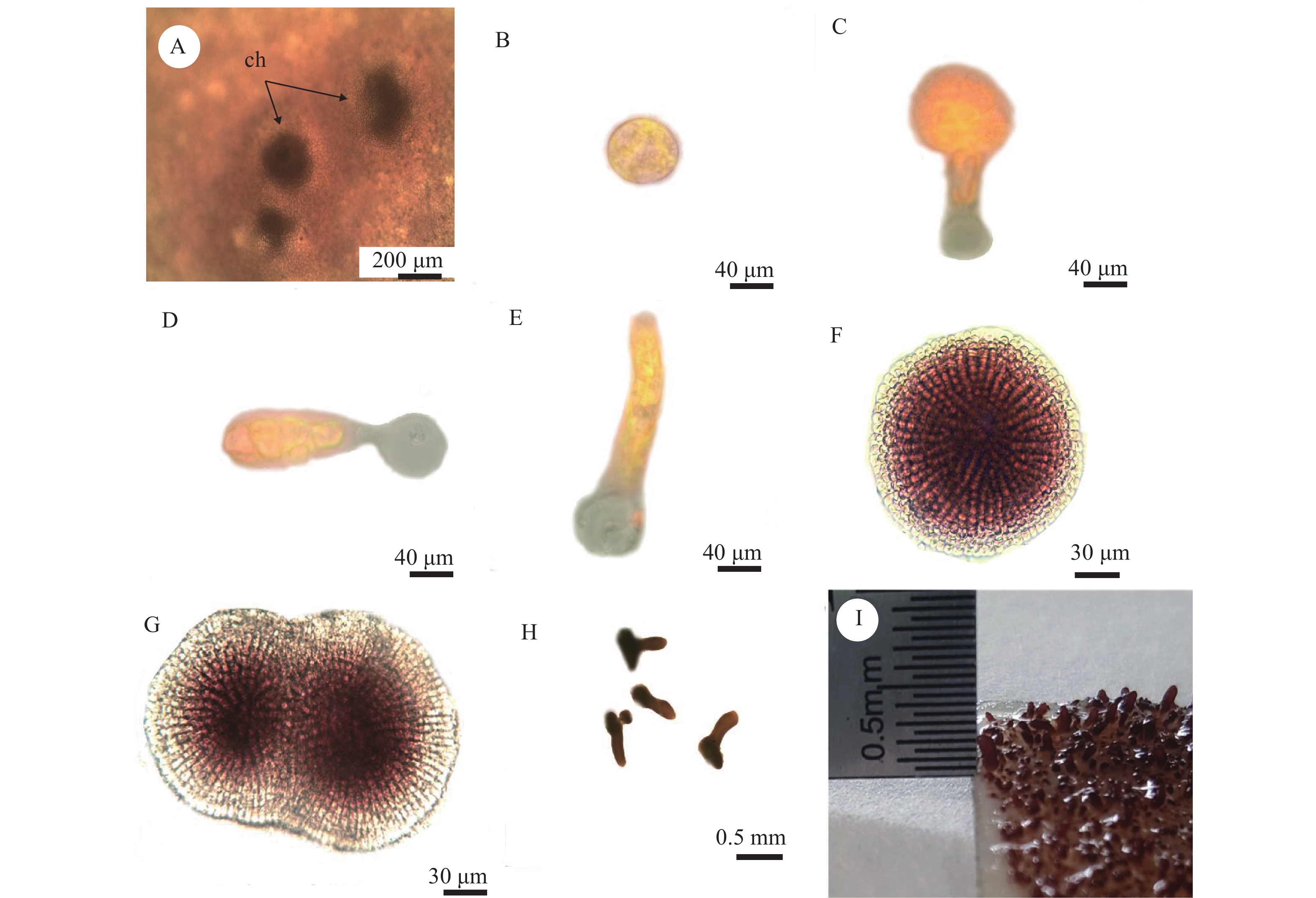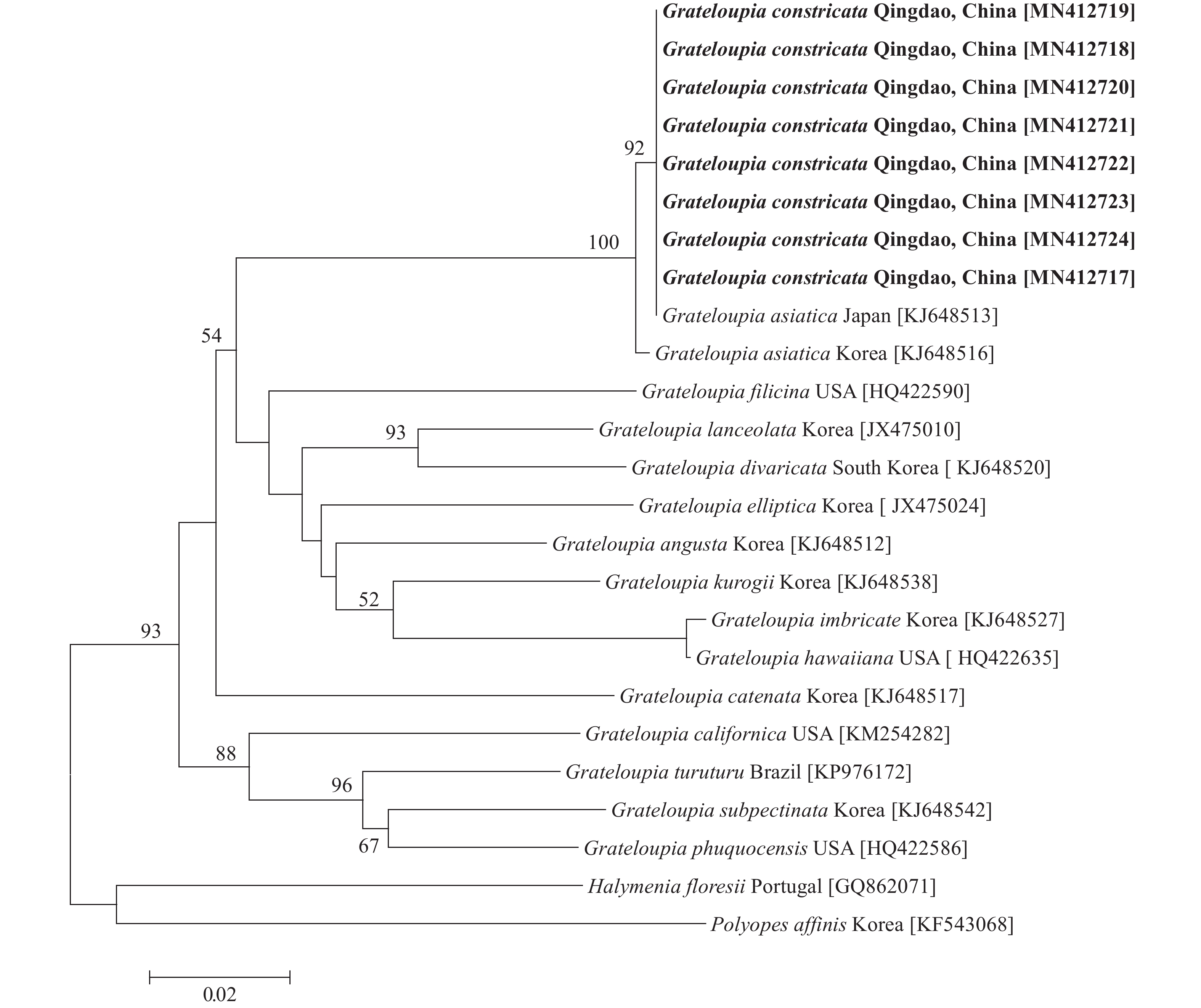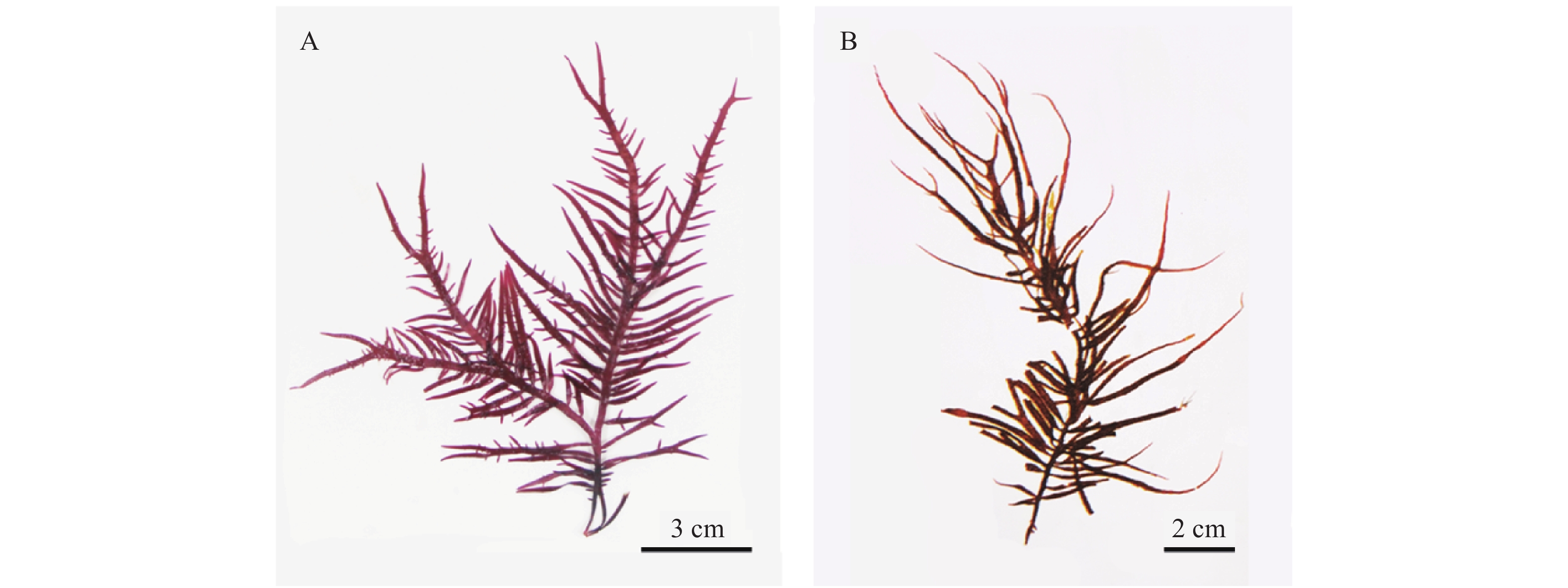RESEARCH ON THE REVISION OF GRATELOUPIA CONSTRICATA LI ET DING BASED ON MORPHOLOGICAL OBSERVATIONS AND EARLY DEVELOPMENT OF SPORES AND MOLECULAR ANALYSES
-
摘要: 通过形态结构和早期发育过程的观察, 结合分子分析, 对采自青岛(模式标本产地)的缢基蜈蚣藻(Grateloupia constricata Li et Ding)进行了重新鉴定。结果表明: (1)藻体直立, 单生或丛生, 呈红褐色或紫红色, 质地黏滑, 软骨质, 高10—30 cm, 主枝扁平; 1—3回羽状分枝, 小枝对生、互生或偏生, 基部缢缩; 藻体由皮层及髓部构成, 皮层由7—10层细胞组成, 厚80—120 μm, 髓部由不规则排列的髓丝组成, 雌配子体的果胞枝生殖枝丛主枝和辅助细胞生殖枝丛主枝分别由6个和5个细胞构成, 为典型的Grateloupia(6cpb—5auxb)型; 四分孢子囊经十字分裂形成。上述特征均与亚洲蜈蚣藻(G. asiatica Kawaguchi et Wang)一致。(2)缢基蜈蚣藻孢子的早期发育类型为“间接盘状体”型, 其早期发育过程与亚洲蜈蚣藻一致。(3)基于rbcL基因序列构建的系统树显示, 8个缢基蜈蚣藻样本之间无碱基差异, 与青岛和大连的亚洲蜈蚣藻均无碱基差异, 形成独立的进化支, 与韩国和日本的亚洲蜈蚣藻碱基差异分别为2 bp(0.17%)和3 bp(0.25%), 均属于种内差异; 基于COⅠ基因序列构建的系统树显示, 8个缢基蜈蚣藻样本之间无碱基差异, 与产于韩国的亚洲蜈蚣藻无碱基差异, 形成独立的进化支; 通过形态、结构及基因序列分析, 确定缢基蜈蚣藻与亚洲蜈蚣藻为同一种, 根据优先法则, 将缢基蜈蚣藻作为亚洲蜈蚣藻的同物异名。Abstract: Through morphological and early development observation followed by molecular analysis, we re-examined Grateloupia constricata Li et Ding collected from Qingdao, Shandong Province. The results showed that: (1) The thalli were upright, brown-red or purple-red, single or clustered, up to 10—30 cm high fleshy and gelatinous in texture. The first branch was flat with pinnately branched 1—3 orders. The branches were reversed, alternate or partial and usually constricted or tapered at the base. Thallus were composed of cortex and medulla. The cortex had 7—10 cell layers and the medulla was consisted of many rhizoidal filaments, 80—120 microns thick, The medulla is consisted of an irregular arrangement of medullary filament. Carpogonial branch ampullae had six cells, auxiliary cell ampullae had five cells (6cpb-5auxb type). Gametophytes dioecious, mature tetrasporangia originated from inner cortex cells and splited into cross. The above characteristics were similar to those of G. asiatica Kawaguchi et Wang. (2) The early developmental type of G. constricata Li et Ding was ‘mediate discal type’, which is consistent with G. asiatica. (3) Based on the phylogenetic tree constructed by rbcL sequences, there was no sequence divergence between the eight samples of G. constricata and G. asiatica from Qingdao and Dalian, which formed a single monophyletic subclade within the large Grateloupia clade of Halymeniaceae. The rbcL sequences differences between G. constricata and G. asiatica from South Korea and Japan were 2 bp (0.17%) and 3 bp (0.25%), which were intraspecific difference. Based on the phylogenetic tree constructed by gene (COⅠ), there was no sequence divergence between the eight samples of G. constricata and G. asiatica from South Korea, which formed a single monophyletic subclade. Consideringmorphological observations and molecular analysis, G. constricata Li et Ding and G. asiatica Kawaguchi et Wang were proved to be the same species. Accroding to the priority rule, G. constricata Li et Ding was the synonym of G. asiatica.
-
-
图 2 缢基蜈蚣藻囊果
A. 缢基蜈蚣藻羽枝基部存在缢缩(小箭头所示), 囊果在主枝和小枝上均有分布(c, 囊果); B. 主枝上的囊果及囊果孔展示(c, 囊果; ch, 囊果孔)
Figure 2. Branches of G. constricata Li et Ding
A. Branches of G. constricata Li et Ding with constricted at bases (small arrowheads) and cystocarps distributed on axes and lateral branches of G. constricata Li et Ding (c, cystocarp); B. Cystocarp distribution on axes(c, cystocarp; ch, cystocarp hole)
图 3 缢基蜈蚣藻内部结构
A、B. 藻体的横切面观(mf, 髓丝); C. 雌配子体的果胞枝生殖枝丛横切面观(1—6. 果胞枝生殖枝丛主枝; ca. 果胞); D. 雄配子体的精子囊; E、F. 雌配子体的辅助细胞生殖枝丛横切面观(1—5, 辅助细胞生殖枝丛主枝; ac, 辅助细胞); G、H. 囊果连续的发育过程; G. 幼小囊果; H. 成熟囊果; I. 果孢子放散; 切片标本号: LNU17060506、LNU17060516、LNU17060536、LNU17060565
Figure 3. The internal structure of G. constricata Li et Ding
A, B. Cross-section of the thallus (mf, medullary filament); C. Transection of carpogonial branch ampullae from female gametophyte (1—6, leader branch carpogonial branch ampullae; ca, carpogonium); D. Spermatangium of male gametophyte; E, F. Transection of auxiliary cell ampullae from female gametophyte (1—5, leader branch of auxiliary cell ampullae; ac, auxiliary cell); G, H. Cystocarp development; G. Little cystocarp; H. Developing cystocarp; I. Release of mature carpospores. Section number: LNU17060506, LNU17060516, LNU17060536, LNU17060565
图 4 缢基蜈蚣藻四分孢子体内部结构
A. 四分孢子囊表面观; B. 四分孢子囊母细胞及二分体 (tm, 四分孢子囊母细胞; dy, 二分体); C. 成熟的四分孢子囊。切片标本号: LNU17060512
Figure 4. The internal structure of tetrasporophyte of G. constricata Li et Ding
A. Tetrasporophyte surface view; B. Tetrasporoblas and formed dyad (tm, tetrasporoblas; dy, formed dyad); C. Etrasporangia cross division, Section number: LNU17060512
图 5 缢基蜈蚣藻果孢子的萌发过程
A. 藻体表面的囊果(ch, 囊果孔); B—E为荧光显微镜拍摄结果; B. 果孢子; C. 果孢子内原生质体迁移; D—E. 萌发管内细胞分裂过程; F. 盘状体时期; G. 盘状体融合的过程; H. 直立芽体形成; I. 直立枝
Figure 5. The development of carpospores in G. constricata
A. Carposporophytes on the surface of thalli (ch. cystocarp hole); B—E were taken with a fluorescence microscope; B. Carpospores; C. Transformation of protoplasts in the germ tube; D—E. Cell division in the germ tube; F. Discoid crust; G. Fusion of discoid crust; H. Upright branches; I. Growth of sporeling
图 6 缢基蜈蚣藻基于rbcL基因的ML系统树
分支上的数字展示基于1000次重复的支持率, 只显示支持率大于50%的数值, Halymenia floresia Malaysia和Polyopes constrictus Australia作为外群, 粗体字为本文研究种; 下同
Figure 6. Maximum likelihood tree based on rbcL gene of G. constricata
Numerals at internal nodes are bootstrap values (1000 replicates), only values above 50% bootstrap support are shown, Halymenia floresia Malaysia and Polyopes constrictus Australia were used as outgroups. Boldfaced words are the species studied in this study. The same applies below
表 1 缢基蜈蚣藻的标本号、采集地点和基因登录号
Table 1 Specimen No., collection information and GenBank accession number
标本编号Specimen No. 采集地点Collection information 基因登录号GenBank accession number rbcL COⅠ LNU2017060501 The First Swimming Beach, Qingdao, China MN412709 MN412717 LNU2017060502 The First Swimming Beach, Qingdao, China MN412710 MN412718 LNU2017060503 The First Swimming Beach, Qingdao, China MN412711 MN412719 LNU2017060504 Luxun Park, Qingdao, China MN412712 MN412720 LNU2017060505 Luxun Park, Qingdao, China MN412713 MN412721 LNU2017060506 Luxun Park, Qingdao, China MN412714 MN412722 LNU2017060507 Maidao, Qingdao, China MN412715 MN412723 LNU2017060508 Maidao, Qingdao, China MN412716 MN412724 表 2 缢基蜈蚣藻和亚洲蜈蚣藻的形态比较
Table 2 Comparison of morphological features between G. constricata and G. asiatic
形态学特征Morphological characteristics 缢基蜈蚣藻G. comstricata 亚洲蜈蚣藻G. asiatica 外部形态External morphology 藻体直立, 红褐色或紫红色, 高10—30 cm, 主枝扁平; 1—3回羽状分枝, 小枝对生、互生或偏生, 基部缢缩 藻体直立, 紫红色, 高10—30 cm,主枝扁压, 基部缢缩, 呈圆柱状, 宽2—5 mm;主枝二叉分枝, 小枝不规则羽状分枝 质地Texture 软骨质 软骨质 皮层数Cortex (C) 7—10层 7—10层 四分孢子囊形态和大小Tetrasporangia morphology and size 长椭圆形: 36—52 μm×14—20 μm 长椭圆形: 40—50 μm×15—20 μm 髓部Medullary structure 非中空 非中空 配子体Gametophyte 雌雄异体 雌雄异体 分布Native regions 中国青岛 中国大连、青岛 辅助细胞生殖枝丛类型Auxiliary cell ampullae Grateloupia型(6cpb-5auxb) Grateloupia型(6cpb-5auxb) 文献Reference 本研究; 夏邦美, 2004 Kawaguchi et al., 2001 -
[1] Wang H W, Kawaguchi S, Horiguchi T, et al. Reinstatement of Grateloupia catenata (Rhodophyta, Halymeniaceae) on the basis of morphology and rbcL sequences [J]. Phycologia, 2000, 39(3): 228-237. doi: 10.2216/i0031-8884-39-3-228.1
[2] Kawaguchi S, Wang H W, Horiguchi T, et al. A comparative study of the red alga Grateloupia filicina (Halymeniaceae) from the Northwestern Pacific and Mediterranean with the description of Grateloupia asiatica sp. nov [J]. Journal of Phycology, 2001, 37(3): 433-442. doi: 10.1046/j.1529-8817.2001.037003433.x
[3] 李芳, 姜朋, 赵树雨, 等. 帚状蜈蚣藻的修订研究—基于形态观察和rbcL序列分析 [J]. 水生生物学报, 2016, 40(6): 1249-1256. doi: 10.7541/2016.163 Li F, Jiang P, Zhao S Y, et al. Research on the revision of Grateloupia fastigiata Li et Ding (Rhodophyta, Halymeniaceae) based on morphological observations and rbcL sequence analyses [J]. Acta Hydrobiologica Sinica, 2016, 40(6): 1249-1256. doi: 10.7541/2016.163
[4] 刘芳, 田依琳, 王宏伟, 等. 对枝蜈蚣藻的修订研究—基于形态观察和rbcL序列分析 [J]. 水生生物学报, 2017, 41(6): 1276-1284. Liu F, Tian Y L, Wang H W, et al. Research on the revision of Grateloupia didymecladia Li et Ding (Rhodophyta, Halymeniaceae) based on morphological observations and rbcL sequence analyses [J]. Acta Hydrobiologica Sinica, 2017, 41(6): 1276-1284.
[5] 夏邦美. 中国海藻志 [A]. 第二卷 红藻门, 第三册 隐丝藻目 [C]. 北京: 科学出版社, 2004: 57-59. Xia B M. Flora Algarum Marinarum Sinicarum [A]. Tomus II Rhodophyta. Part III. Cryptonemiales [C]. Beijing: Science Press, 2004: 57-59.
[6] De Clerck, Gavio O B, Fredericq, et al. Systematics of Grateloupia filicina (Halymeniaceae, Rhodophyta), based on rbcL sequence analysis and morphological evidence, including the reinstatement of G. minima and the description of G. capensis sp. nov. [J]. Journal of Phycology, 2005, 41(2): 391-410. doi: 10.1111/j.1529-8817.2005.04189.x
[7] Nelson W A, Kim S Y, Boo S M, et al. The first record of Grateloupia subpectinata from the New Zealand region and comparison with G. prolifera, a species endemic to the Chatham Islands [J]. Botanica Marina, 2013, 56(5-6): 507-513.
[8] Sherwood A R, Presting G G. Universal primers amplify a 23S rDNA plastid marker in eukaryotic algae and cyanobacteria [J]. Journal of Phycology, 2007, 43(3): 605-608. doi: 10.1111/j.1529-8817.2007.00341.x
[9] Wang H W, Kawaguchi S, Horiguchi T, et al. A morphological and molecular assessment of the genus Prionitis J. Agardh (Halymeniaceae, Rhodophyta) [J]. Phycological Research, 2001, 49(3): 251-261. doi: 10.1111/j.1440-1835.2001.tb00255.x
[10] Miller K A, Hughey J R, Gabrielson P W, et al. Research note: First report of the Japanese species Grateloupia lanceolata (Halymeniaceae, Rhodophyta) from California, USA [J]. Phycological Research, 2009, 57(3): 238-241. doi: 10.1111/j.1440-1835.2009.00542.x
[11] Lee J I, Kim H G, Geraldino P J L, et al. Molecular classification of the genus Grateloupia (Halymeniaceae, Rhodophyta) in Korea [J]. Algae, 2009, 24(4): 231-238. doi: 10.4490/ALGAE.2009.24.4.231
[12] Yang M Y, Kim M S. Taxonomy of Grateloupia (Halymeniales, Rhodophyta) by DNA barcode marker analysis and a description of Pachymeniopsis volvita sp. nov. [J]. Journal of Applied Phycology, 2015, 27(3): 1373-1384. doi: 10.1007/s10811-014-0432-1
[13] Sherwood A R, Sauvage T, Kurihara A, et al. The Hawaiian Rhodophyta Biodiversity Survey (2006-2010): a summary of principal findings [J]. BMC Plant Biology, 2010, 10(1): 258. doi: 10.1186/1471-2229-10-258
[14] Yu L, Wang H W, Luan R X. Grateloupia tenuis Wang et Luan sp. nov. (Halymeniaceae, Rhodophyta): a new species from South China Sea based on morphological observation and rbcL gene sequences analysis [J]. Biomed Research International, 2013(3): 560163.
[15] Wang H W, Guo S R, Zhang X M, et al. Re-identifying of the Grateloupia yangjiangensis (Rhodophyta, Halymeniaceae) on the basis of morphological observations, life history and rbcL sequence analyses [J]. Acta Oceanologica Sinica, 2014, 33(4): 77-84. doi: 10.1007/s13131-014-0450-5
[16] Koichiro T, Daniel P, Nicholas P, et al. MEGA5: Molecular evolutionary genetics analysis using maximum likelihood, evolutionary distance, and maximum parsimony methods [J]. Molecular Biology and Evolution, 2011, 28(10): 2731-2739. doi: 10.1093/molbev/msr121
[17] Chiang Y M. Morphological studies of the red algae of the family Cryptonemiaceae [J]. University of California Publications in Botany, 1970(58): 1-95.
[18] Gargiulo G M, Morabito M, Manghisi A. A re-assessment of reproductive anatomy and postfertilization development in the systematics of Grateloupia (Halymeniales, Rhodophyta) [J]. Cryptogamie, Algologie, 2013, 34(1): 3-35. doi: 10.7872/crya.v34.iss1.2013.3
[19] 王宏伟, 李雅卓, 曹翠翠, 等. 亚洲蜈蚣藻(Grateloupia asiatica Kawaguchi et Wang)孢子发育及生活史的研究 [J]. 辽宁师范大学学报(自然科学版), 2014(2): 246-251. Wang H W, Li Y Z, Cao C C, et al. A study on the spore development and life cycle of Grateloupia asiatica Kawaguchi et Wang (Halymeniaceae, Rhodophyta) [J]. Journal of Liaoning Normal University (Natural Science Edition), 2014(2): 246-251.




 下载:
下载:






